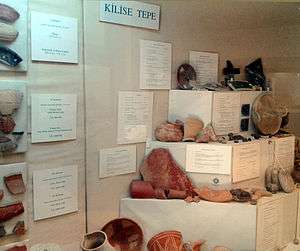Kilise Tepe
Kilise Tepe is a mound in Mersin Province, Turkey. It was formerly known as Maltepe. The original name of the mound is not known and Kilise Tepe in Turkish means "church-hill" referring to a church ruin.

Geography
The mound is situated in the rural area of Mut at 36°29′N 33°33′E close to road connecting Turkish state way ![]()
History
The earliest settlement is dated to third Millennium BC. During the Hittite Empire era, it was used to control the road between the Hittite lands in Central Anatolia and the Mediterranean ports. [1] At the end of the 13th Century BC, the settlement was burnt down, like much of Anatolia at the time. In its wake, a reconstruction began, but this too was destroyed in the middle of the 12th Century BC[2][3]. Mycenaean LHIIIC pottery from Cyprus and Crete[4] was found in this layer, dating from 1200 to 1150 BC. Settlement continued during the Hellenistic period, but there is no indication of a settlement during the Roman period. The ruined church is an early 5th century Byzantine church.
Excavations
The excavations began in 1994 as a joint effort between Cambridge University and Newcastle University and continued until 1997.[5][6][7][8][9]After a pause the excavations resumed in 2007.[10][11][12] The Cambridge team is headed by Nicholas Postgate and is responsible for the Iron Age excavations. The Newcastle team is headed by Mark Jackson and is responsible for the Byzantine excavations. This work continued until 2011.[13] The Turkish collaborators were Çanakkale Onsekiz Mart University in the 2010–2011 term and Bitlis Eren University in later terms. The findings are exhibited in Silifke Museum.
Notes
- Mersin Ören Yerleri Kaleleri Müzeleri ISBN 978-605-4196-07-4, p 325
- Symington, Dorit (2001). "Hittites at Kilise Tepe". Publications de l'Institut Français d'Études Anatoliennes. 13 (1): 167–184.
- Hald, Mette Marie; Kozal, Ekin; Postgate, Nicholas; Miller, Bob. "Further work at Kilise Tepe, 2007-2011: refining the Bronze to Iron Age transition". Cite journal requires
|journal=(help) - Tomlinson, Jonathan E. "Comparison of the NAA Data for Six Mycenaean-style Samples from Kilise Tepe with Chemical Reference Groups from Mainland Greece, Crete, Cyprus and the Levant". Cite journal requires
|journal=(help) - H. D. Baker et al, Kilise Tepe 1994, Anatolian Studies, vol. 45, pp. 139-191, December 1995
- Postgate, J.N., Kilise Tepe 1994: A Summary of the Principal Results, Kazi Sonuçlari Toplantisi I, vol. 17, pp. 419-431, 1996
- Postgate, J.N., Kilise Tepe 1995: A Summary of the Principal Results, Kazi Sonuçlari Toplantisi I, vol. 18, pp. 441-456, 1997
- Postgate, J.N., Kilise Tepe 1996: A Summary of the Principal Results, I, vol. 19, pp. 209-226, 1998
- Jackson, M.P.C. and J.N. Postgate, Kilise Tepe 1997: A Summary of the Principal Results, Kazi Sonuçlari Toplantisi I, vol 20, pp. 541-557, 1999
- Jackson M and Postgate N., Excavations at Kilise Tepe 2007, Kazi Sonuçlari Toplantisi, vol. 30, no. 3, pp. 207-232, 2009
- Collon D, Jackson M, Postgate N., Excavations at Kilise Tepe 2008, Kazi Sonuçlari Toplantisi, vol. 31, no. 1, pp. 159-184, 2009
- Jackson M and Postgate N., Excavations at Kilise Tepe, Kazi Sonuçlari Toplantisi, vol. 32, no. 3, pp. 424-446, 2010
- Christina Bouthillier et al, Further work at Kilise Tepe, 2007-2011: refining the Bronze to Iron Age transition, Anatolian Studies, vol. 64, pp. 95-161, 2014
Further reading
- C. K. Hansen and J. N. Postgate, The Bronze to Iron Age transition at Kilise Tepe, Anatolian Studies, vol. 49, pp. 111-122, December 1999
- J. N. Postgate, The Chronology of the Iron Age seen from Kilise Tepe, Ancient Near Eastern Studies, vol. 45, pp. 166-187, 2008